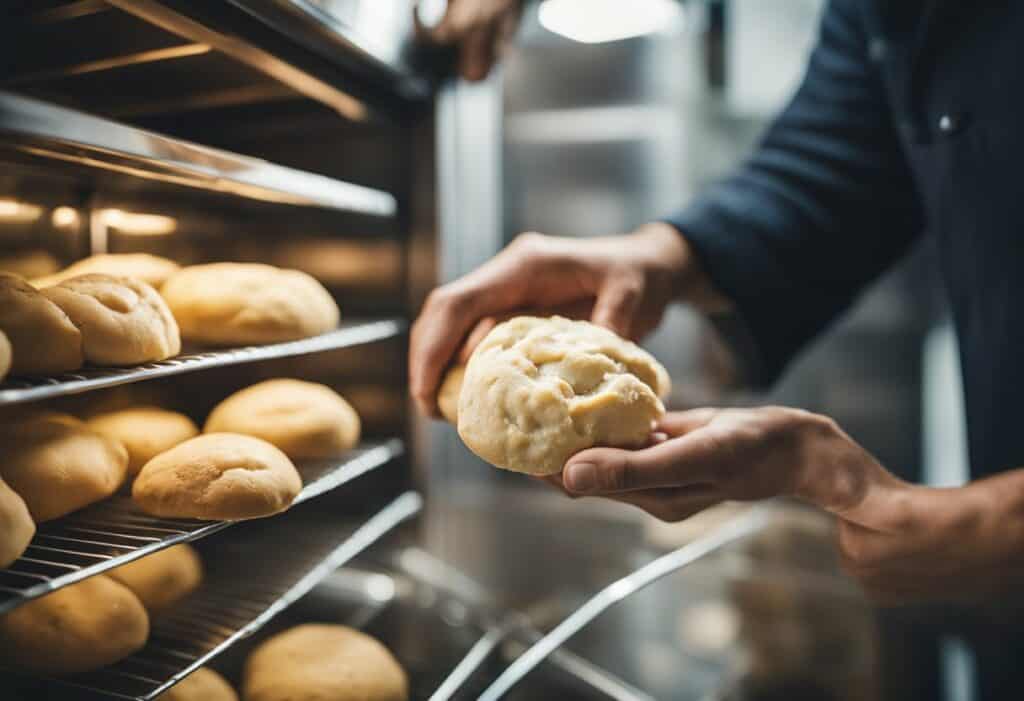Making homemade pizza can be a fun and delicious way to enjoy your favorite meal.
While making pizza dough from scratch can be time-consuming, using store-bought dough can be a great option for those who want to make pizza at home without the hassle.
With the right ingredients and techniques, you can create a tasty pizza that rivals your favorite pizzeria.

Choosing the right store-bought dough is the first step in making homemade pizza. Look for dough that is fresh, pliable, and free of preservatives.
Once you have your dough, it’s important to let it rest and rise before you start making your pizza. This will help the dough to become more elastic and easier to work with.
Preparing the dough is the next step in making homemade pizza. You can use your hands or a rolling pin to stretch the dough into the desired shape and thickness.
Once the dough is ready, it’s time to add your toppings and bake the pizza. With a little practice and patience, you can create a delicious homemade pizza that your family and friends will love.
Key Takeaways
- Choosing the right store-bought dough is crucial for making homemade pizza.
- Letting the dough rest and rise is important for creating a more elastic and pliable dough.
- With the right techniques and ingredients, you can make a delicious homemade pizza that rivals your favorite pizzeria.
Choosing the Right Store Bought Dough

As someone who loves making homemade pizza, I know that choosing the right store bought dough is crucial for a delicious outcome. Here are some tips to help you pick the best dough for your pizza:
Check the Expiration Date
When shopping for store bought dough, always check the expiration date. Make sure you choose a dough that has a later expiration date, so you have enough time to use it.
Look for Dough in the Refrigerated Section
Most grocery stores keep their store bought dough in the refrigerated section. This dough is usually fresher and has a better texture than the ones found in the freezer section.
Consider Convenience
If you’re short on time, consider buying premade dough. Premade dough is ready to use and saves you time and effort. However, keep in mind that it may not be as fresh as refrigerated dough.
Read the Ingredients
When choosing store bought dough, look at the ingredients list. Try to find a dough that has no added sugar and is made with olive oil. These two key ingredients will ensure the dough tastes authentic and delicious.
By following these tips, you can choose the right store bought dough for your homemade pizza and enjoy a delicious meal in no time.
Preparing the Dough
When it comes to making homemade pizza with store-bought dough, preparing the dough is the first and most crucial step. Here are some tips to help you prepare your dough for the perfect pizza:
Room Temperature
Before you start preparing the dough, make sure it is at room temperature. Take the dough out of the refrigerator and let it sit at room temperature for at least 30 minutes. This will make it easier to work with and help it rise properly.
Flour
When working with the dough, be sure to use plenty of flour to prevent it from sticking. Dust your work surface and rolling pin with flour before you begin.
Rolling Pin
A rolling pin is an essential tool for shaping the dough. Roll the dough out into a circle or rectangle, depending on your preference. Be sure to roll it out evenly so that it cooks evenly.
Shape
Once you have rolled out the dough, you can shape it into your desired shape. If you prefer a round pizza, use your hands to stretch and shape the dough.
If you prefer a rectangular pizza, use a rolling pin to shape the dough into a rectangle.
Rise
After shaping the dough, let it rise for about 10-15 minutes. This will help it become lighter and fluffier when cooked.
Stretch and Shape
Before adding your toppings, stretch and shape the dough again. This will help it become even thinner and crispier when cooked. Use your hands to stretch the dough gently, being careful not to tear it.
Docking
Docking is the process of pricking the dough with a fork to prevent it from puffing up during baking. Use a fork to prick the dough all over, making sure to leave a border around the edge.
Par-baking
If you prefer a crispier crust, you can par-bake the dough before adding your toppings. Preheat the oven to 425°F, and bake the dough for 5-7 minutes until it begins to turn golden brown.
Remove from the oven and add your toppings before returning it to the oven to finish baking.
By following these tips, you can prepare your store-bought pizza dough for the perfect homemade pizza.
Setting Up Your Oven

When it comes to making homemade pizza with store bought dough, setting up your oven correctly is crucial.
Preheating your oven is a must, and you should set the temperature to at least 450 degrees Fahrenheit. This will ensure that your pizza cooks evenly and the crust comes out crispy.
It’s important to note that different ovens may vary in temperature and cooking time. Therefore, it’s recommended to invest in an oven thermometer to ensure that your oven is at the correct temperature.
This will also help you adjust the temperature if needed, depending on the thickness of your pizza crust and the toppings you use.
Before putting your pizza in the oven, make sure to remove any racks or trays that may be in the way. You want to have a clear and open space to slide your pizza onto the oven rack or pizza stone.
If you’re using a pizza stone, it’s recommended to preheat it in the oven for at least 30 minutes before baking your pizza on it.
In summary, preheating your oven, using an oven thermometer, and clearing any obstructions are key steps to setting up your oven for homemade pizza success.
Choosing Your Toppings

When it comes to homemade pizza, the toppings are what make it truly customizable and delicious. Here are some ideas for toppings that you can use with your store-bought dough:
Cheese
Cheese is a must-have for any pizza. You can use a variety of cheeses, such as fontina, cheddar, goat cheese, parmesan, or smoked gouda. Consider mixing different cheeses for a more complex flavor.
Sauce
Tomato sauce is the classic choice for pizza, but you can also use pesto or barbecue sauce for a different twist. Spread the sauce on the dough, leaving a little space around the edges.
Meat
Meat toppings like pepperoni, sausage, bacon, ham, prosciutto, or chicken can add protein and flavor to your pizza. Cook the meat before adding it to the pizza.
Vegetables
Vegetables like bell peppers, red onions, mushrooms, jalapenos, or apples can add freshness and crunch to your pizza. Slice them thinly and arrange them on top of the sauce.
Herbs
Herbs like basil, oregano, thyme, or rosemary can add aroma and flavor to your pizza. Sprinkle them on top of the toppings before baking.
Olive Oil
Drizzle some olive oil on top of the pizza before baking to add richness and moisture.
Parmesan Cheese
Grate some parmesan cheese on top of the pizza after baking for extra flavor.
Remember to not overload your pizza with too many toppings, as it can make the crust soggy and difficult to handle. Choose your favorite toppings and have fun experimenting with different combinations.
Making the Pizza
To make homemade pizza with store-bought dough, start by preheating your oven to around 425°F.
Next, prepare your baking sheet by dusting it with cornmeal or lining it with parchment paper to prevent the crust from sticking.
Then, take your premade pizza dough out of the refrigerator and let it sit at room temperature for around 20-30 minutes. This will help the dough become more pliable and easier to work with.
Once your dough is ready, lightly dust your work surface with flour and begin to stretch and shape the dough to your desired thickness and shape.
If you prefer a crispy crust, roll the dough out thinner. If you prefer a thicker, chewier crust, leave the dough a bit thicker.
Next, spread a layer of pizza sauce onto the dough, leaving a small border around the edge for the crust. You can use a homemade sauce or a jarred sauce, depending on your preference.
After the sauce, add your desired toppings. Popular options include mozzarella cheese, vegetables, meats, and herbs like oregano.
Be careful not to overload the pizza with too many toppings as this can cause it to become soggy and difficult to cook properly.
Once your pizza is topped, place it onto your prepared baking sheet and bake in the preheated oven for around 12-15 minutes or until the crust is golden brown and the cheese is melted and bubbly.
If you prefer a crispier crust, you can also try using a pizza stone or a pizza pan instead of a baking sheet. You can also grill your pizza for a smoky flavor.
When the pizza is done, let it cool for a few minutes before slicing and serving. Enjoy your homemade pizza!
Storing and Reheating Leftovers
As someone who loves pizza, I often find myself with leftovers. Whether it’s a few slices or a whole pie, I want to make sure that I store and reheat it properly so that it’s just as delicious as the day I bought it.
Storing Leftover Pizza
If you have leftover pizza, the first thing you need to do is store it properly. You don’t want it to go bad or become stale, so it’s important to put it in the fridge or freezer as soon as possible.
- Fridge: If you plan on eating your leftover pizza within the next few days, store it in the fridge. Put it in an airtight container or wrap it tightly in plastic wrap or aluminum foil. This will help keep it fresh and prevent it from drying out.
- Freezer: If you don’t plan on eating your leftover pizza within the next few days, you can freeze it. Wrap each slice or the entire pizza tightly in plastic wrap or aluminum foil, and then put it in an airtight container or a freezer bag. Frozen pizza can last up to 2 months in the freezer.
Reheating Leftover Pizza
When it comes to reheating leftover pizza, there are a few different methods you can use. Here are some of the most common ways to reheat your pizza:
- Oven: Preheat your oven to 375°F. Place the pizza slices on a baking sheet and bake for 5-10 minutes, or until the cheese is melted and the crust is crispy.
- Microwave: Place the pizza slices on a microwave-safe plate and microwave for 30 seconds to 1 minute, or until the cheese is melted and the crust is warm. Be careful not to overheat it, as this can make the crust soggy.
- Grilled Pizza: If you want to try something different, you can also grill your leftover pizza. Preheat your grill to medium-high heat and place the pizza slices directly on the grates. Grill for 2-3 minutes on each side, or until the cheese is melted and the crust is crispy.
No matter which method you choose, make sure you keep an eye on your pizza to prevent it from burning or becoming too dry.
With these tips, you can enjoy your leftover pizza just as much as the day you bought it!
Tips and Tricks
I have experimented with store-bought pizza dough for quite some time now, and I have come up with a few tips and tricks that can help you make delicious homemade pizza. Here are my top recommendations:
- Let the Dough Rest: Before you start working with the dough, let it rest at room temperature for about 30 minutes. This will make it easier to stretch and shape the dough.
- Use Cornmeal: Sprinkle some cornmeal on your baking sheet or pizza stone before placing the dough on it. This will help prevent the dough from sticking and give it a nice crunch.
- Add Sugar: Adding a small amount of sugar to your pizza dough can help it caramelize and turn golden brown when baked.
- Be Creative with Toppings: Don’t be afraid to experiment with different toppings. Some of my favorite combinations include sage and fontina cheese, fresh basil and tomato, and prosciutto and arugula.
- Preheat the Oven: Make sure to preheat your oven to the highest temperature possible for at least 30 minutes before baking your pizza. This will ensure that the crust gets crispy and the cheese melts perfectly.
By following these tips and tricks, you can easily make restaurant-quality pizza at home using store-bought dough. So, go ahead and plan your next pizza night with confidence!
Frequently Asked Questions

How long should store bought pizza dough sit out before using?
Store bought pizza dough should sit out at room temperature for at least 30 minutes before using. This will make it easier to stretch and shape.
Should you let store bought pizza dough rise before using?
Yes, letting store bought pizza dough rise before using will make it lighter and more flavorful. Follow the package instructions for the best results.
What is the best temperature to cook store bought pizza dough?
The best temperature to cook store bought pizza dough is at 425-450°F. This will give you a crispy crust without burning the toppings.
What are some good toppings for homemade pizza?
There are endless possibilities for topping homemade pizza. Some classic options include tomato sauce, mozzarella cheese, pepperoni, mushrooms, and bell peppers. Get creative and try out new combinations!
How can I make my homemade pizza dough crispy?
To make your homemade pizza dough crispy, use a pizza stone or preheat a baking sheet in the oven before placing the pizza on it. This will help the crust cook evenly and become crispy.
What are some common mistakes to avoid when making homemade pizza?
Some common mistakes to avoid when making homemade pizza include overloading the pizza with toppings, not preheating the oven, and using too much flour when stretching the dough.
Keep it simple and follow the instructions carefully for the best results.







